Late last year, PS contributor Drew Frye noticed a fellow sailor practicing the classic downward-pretzel boat yoga position, trying to free a leaking diesel tank from the bilge. It had perforated through from the inside-out. The sending unit was corroded to bits. A few days later, after sending a sample of the tank bottom water to a lab, Frye learned that the fuel was contaminated with salt water, containing the equivalent of 23 percent of the ocean salinity.
Photos by Drew Frye; product photos courtesy of manufacturers
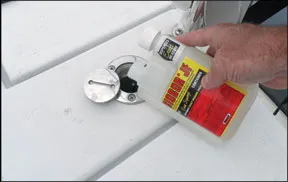
The cause was a mystery. A leaking filler cap? The O-ring seemed fine. Did it come with a delivery? Certainly, local marina tanks have gone under water more than once, as recently as Hurricane Sandy, taking some water each time. Spray through the vent? Possibly. The pH of the bottom water was very low-about 4.5 (pH 7 is considered neutral)-and that certainly contributed to the corrosion. The low pH could have been caused by biological contamination, but the filters yielded no clear evidence. Whatever the root cause, a tank full of normally noncorrosive diesel had become aggressively corrosive.
Practical Sailor has tested gasoline additives for corrosion prevention (PS, August 2012) and found that some performed beautifully and some actually seemed to promote corrosion. To test, we modeled the effect of seawater splashing into tanks through the fill cap. We also simulated the effects of condensation within the tank-a serious problem with E10 (fuel containing 10-percent ethanol).
Diesel fuel presents a different challenge. Unlike relatively sterile gasoline, diesel can be a fertile breeding ground for bacteria that can accelerate corrosion. Bacteria grow in the diesel and water mixture, attach to the tank walls and begin digesting the tank. Severe infections can be disastrous, as colonies drill jagged holes right through the tank wall. It can also make the diesel go sour; high concentrations of acetic acid (vinegar) have been found at the bottom of diesel tanks. Weve found acid levels as low as pH 4 and acetate levels equivalent to a 30-percent white vinegar solution.

Could ethanol be a part of the problem? A controversial paper by the Battelle research organization suggests that inadvertent contamination of diesel with ethanol during transit may be responsible for recent increases in corrosion in ultra-low sulfur (ULS) diesel tanks. Seawater remains a potential cause. Although saltwater intrusion seems less likely in a boats tank than for a dinghy outboard, our research indicated that 20- to 30-percent salinity is common among problem tanks.
Our August 2012 article reported on the effectiveness of common fuel additives in reducing salt-induced galvanic corrosion in E10 fuel systems. At first, we tested 0.03-percent seawater in E10, and then we reduced the exposure to 0.015 percent seawater, the equivalent of just four drops in a one-quart tank. We let these sit with controlled ventilation under normal atmospheric conditions for two months and observed the changes. This seemed like a reasonable scenario for a dinghy outboard, and our results neatly paralleled corrosion found in the carburetors of small outboards we have examined. Some additives stopped corrosion in its tracks, others not so much, and some made it even worse than untreated gasoline. Based on our experience in that test, we took a similar approach in this diesel test. (See How We Tested.)
As mentioned, biological contaminants (fuel bugs) can cause corrosion, too, but creating a controlled experiment to evaluate a products effectiveness against this type of corrosion is difficult. The level of corrosion will depend greatly on the exact locations of the colonies, and these colonies may be widely scattered in the tank. Unless we induced unrealistically high levels of contamination (to the point of clogging filters), it would be hard to judge a products effectiveness against corrosion.
In our previous tests of diesel biocide additives (PS, July 2009), we found that although all of the biocides were effective, some did better on one culture and others did better on a different culture-making it difficult to pick an overall winner. In any case, it was clear that products are available to combat bacteria, which would in turn, prevent bacteria-borne corrosion, so we felt testing for this would be redundant, as well as difficult to interpret. Instead, we focused on water.
Managing Corrosive Oil
For insight into this project, we looked at how refiners deal with corrosion from salt water and sour crudes. After all, industrial fuel storage tanks are nothing special-ordinary carbon steel-and refiners can’t afford to lose million-dollar tanks or risk spills or fires due to tank failure.
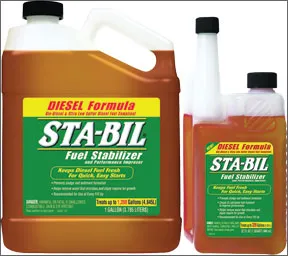
Linings: When corrosive crudes or salt are expected, tanks are lined on the floor and 6 feet up the sidewalls with a variety of epoxy or vinyl-ester based products. This isn’t practical as a small-boat retrofit-its impossible to get the steel ready without sand-blasting the interior-but it is worth exploring for new steel tanks. If the bottom and sides are coated, the risk of internal corrosion becomes trivial for the next 20 years. Lining aluminum tanks has been less successful.
Corrosion inhibitors: Fuel storage facilities will pick from a long list of products designed for the fuels they have. Corrosiveness is monitored through routine sampling, and metal coupons, used to indicate corrosion, are installed in strainers and other easily accessed points. A polished washer made of the same material as the tank placed in an oil-water separating filter might be a good way for a sailor to keep tabs on his fuel.
Tank inspection: Spill prevention regulations require all land-based tanks to be inspected every five years by a certified inspector. These inspections include detailed visual inspection, ultrasonic thickness testing, hydrostatic testing, bubble testing, and sometimes, additional tests at the discretion of the inspector. The goal is to catch corrosion issues before they become serious and to take corrective action. The greatest inspection challenges are cleaning and access, just as they are for the boat owner.
But it doesn’t always work. Linings can fail, and inspectors can only test what they can reach. Often, it is only the bottom that leaks, and these leaks are hard to find without either entering the tank or waiting for the oil to come out. On a boat tank, a good cleaning followed by a very close visual inspection with a flashlight would certainly reveal whether there was active corrosion, but it requires a very clean tank and a diligent inspector who looks in every corner.
What We Tested
We tested seven products representing a cross-section of what is on the market: Hammonds Biobor JF, Valvtect Bioguard, Fuel Rights Basic Formula, Stanadyne Performance Formula, Gold Eagles Sta-Bil Diesel, Star brite Star Tron Enzyme for Diesel, and Sea Foam Motor Treatment. Based on results from our prior testing, we also tested a blend of two products, the Biobor JF and Star Tron. After our testing began, Valvtect introduced a new, ultra-low sulfur formula to replace its original blend. It also unveiled a product called Bioguard Plus 6, which-unlike the formula we tested-is designed to combat water-induced corrosion, among other things. We plan to include that product in future testing.

All of the tested products make essentially the same recommendations and claims: Their product should be used on a regular basis and before long-term storage. Some are marketed as performance additives, others as storage additives, and some only for microbiological control. We dosed each additive according to label recommendations. All products mixed easily with diesel.
Observations
Many of the samples began to show corrosion effects within a few days. Hydrogen gas bubbles appeared on the steel coupons of the control and several less-effective additives. Considerable amounts of corrosion product settled into the bottom water, possibly contributing to filter plugging; only the Recommended products did not drop solids into the bottom water.
Testers gently degreased all samples and wiped them clean of all loose corrosion before carrying out a detailed examination and photographing the samples. This greatly reduced the obvious visual range between the best and worst, but it also allowed testers to closely examine the pitting, which is the most critical factor. Except for Star Tron, the coupon assemblies generally showed more severe damage on the spacers and the edges of coupons than on the faces that were photographed.
We also observed considerable corrosion on the air-exposed portion of many coupons. We intentionally left the coupon tips exposed to air, as our experiences and research indicated that considerable corrosion in the vapor space is common. This is not surprising considering the volatility of acetic acid. Only Star Tron was able to control corrosion in the vapor space. This might just save your fuel-level gauges sending unit.
Testers observed no corrosion during the test period in any of the clean control samples that were not dosed with corrosive water. All samples appeared new. With the addition of the synthetic corrosive water, however, testers observed the rapid corrosion of steel and discoloration of copper and brass.
Biobor JF
Biobor JF is perhaps the most widely used biocide for diesel and jet fuel. It has proven very effective against biological contaminants, and rated highly in our biocide testing trials. Unfortunately, it apparently does nothing to combat water-induced corrosion. However, Biobor EB, a product intended for ethanol gasoline, was among the top performers in PSs gasoline corrosion inhibitor test, so we would encourage Biobor to look into creating a similar corrosion inhibitor for diesel or creating a combined product.
Interestingly, the combined Star Tron/Biobor JF blend performed well against corrosion. Assuming this blend retains Biobors bacteria-fighting ability, this would be a good concoction to use regularly. Biobor JF is available in 16- and 32-ounce dispenser bottles. Bottom line: Not recommended for corrosion control.

Fuel Right
This product, one of the most expensive in our comparison, was not tested in our previous biocide trial. It is not a registered biocide, although the company claims protection against biological growth.
While the product has its supporters, it was the only product tested that made corrosion worse than the control, and it was the only product that induced pitting in the aluminum sample. Perhaps an increased dose would have helped-it had by far the lowest usage rate-but the product literature did not suggest higher rates for special purposes. Available in 16-ounce, 32-ounce, and 1-gallon bottles, this product is a good example of why boaters need to be wary about manufacturers claims. Bottom line: Not recommended.
Sea Foam
Recreational fishermen have been using Sea Foam Motor Treatment for years to resurrect balky outboards. While our prior tests found it very effective in ethanol gasoline-and we certainly recommend it for tender outboards-the product did not perform well in diesel. It is available in 16-ounce cans through auto parts supply chains. Bottom line: Not recommended.
Sta-Bil Diesel
Although not the top performer-it allowed slight surface corrosion of steel samples-testers felt that this product did a respectable job of preventing serious corrosion. There was no pitting in the test coupon; the control and several other additives allowed countless small craters in the steel sample. Available in 8-, 16-, and 32-ounce dispenser bottles. Bottom line: Recommended.
Stanadyne Performance Formula
Not a top performer. Although it did reduce the depth of pitting of steel in the presence of copper and brass, it provided little protection for copper or brass. It did not protect steel when coupled with aluminum. Previously, we have tested this formula as a biocide–it is not–but that should not be counted against it as a regular-use additive. It is available in 8-, 16-, and 64-ounce bottles, as well as 5-gallon and 55-gallon containers. Bottom line: For steel or fiberglass tanks only.
Star Tron Enzyme
This product was a clear winner. The tank bottom sample showed some darkening but no pitting. All other samples showed only patina. Early observations led us to add an additional test sample containing Biobor JF (for its biocide) and Star Tron (for its corrosion-fighting) to see if the pairing worked well, which it did. Previously (PS, July 2009), Star Tron was tested against registered biocides including Biobor JF and Valvtect Bioguard. Although the manufacturer does not claim Star Tron to be a biocide, it did show an ability to control biological growth, giving us one more reason to recommend this product. While we have not been impressed with the Star Tron line in gasoline applications, in diesel it seems to be a winner. Bottom line: This is our Best Choice.
Valvtect Bioguard
Valvtect Bioguard was also very effective in the diesel biocide trials, but it uses a different biocide chemistry than Biobor. The corrosion protection on the steel sample that was galvanically coupled was not very good, nor was the protection of brass and copper; however, the non-coupled sample that was set in the bottom water was the best of the group, and the aluminum sample also did very well. That, combined with known effectiveness as a biocide, make this product a good choice.
Testers did note some discoloration of the fuel and bits of corrosion product in the bottom water, but we felt that the obvious protection that it provided for the bottom plate still merited a recommendation. Unless your tank has a great deal of bottom water and the fuel system entails a significant use of dissimilar metals-there should be neither-this product would afford good protection for the bottom of the tank. Available in 8-, 16-, and 32-ounce bottles. Bottom line: Recommended.
Conclusion
Keeping water out of diesel fuel is critical. Based on our testers long experience as a certified API 653 tank inspector, the control sample would perforate a typical steel tank in less than five years. Even tiny amounts cause trouble that additives may not be able to protect the tank from. This, of course, raises the question: Which tank material is best? We examined this question in detail (PS, May 2007) and concluded that although there are more corrosion-resistant materials (like monel) available, aluminum (5052, 5083, or 5086 series) remains the most practical choice in most cases.
Star Tron and Sta-Bil proved very effective, greatly limiting corrosion. The others did little and were perhaps overwhelmed by our worst-case challenge. But we don’t buy additives to protect us from good clean diesel; we buy additives to protect us when things go very wrong, and fuel contamination-as the poor fellow removing his tank from the bilge can attest-can easily go undetected. We think the Recommended additives deliver a good value in preventive maintenance.
We also think a do-it-yourself tank-testing program makes a lot of sense, based upon the truly corrosive bottom-water samples we found. By routinely testing the pH of water drained from the fuel/water separator and by inserting a polished washer made of the same material as the tank somewhere in the filter train, boater owners can get a valuable early warning before serious corrosion of the tank or fuel system can occur. The tanks pH should stay between 6 and 8, and the metal coupon should never change appearance in good fuel.
After testing began, we wondered whether moisture-absorbing vent filters might help combat corrosion. Our testing of vent filters on E10 gasoline showed 50- to 75-percent reductions in corrosion and water absorption, and our earlier testing of diesel vent filters showed that they could eliminate water hazing caused by temperature fluctuations during cool, humid conditions. Were hopeful that vent filters may have a similar effect on diesel. A month before this testing commenced, we began a parallel test to compare corrosion rates, with and without a vent filter. We installed vent filters on several test boats as well, to generate field reports. We expect to see some interesting results in this experiment as the summer passes, and well report back.
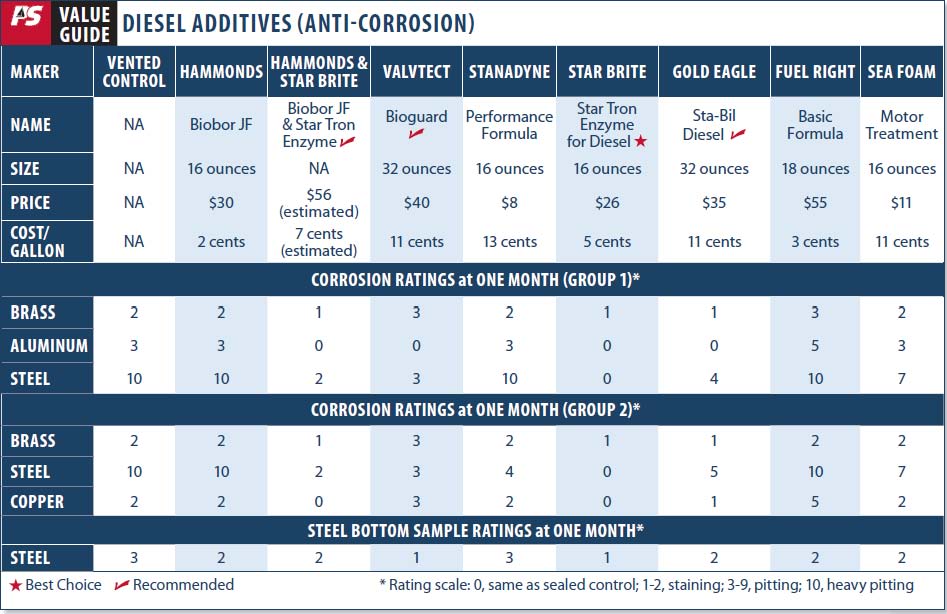
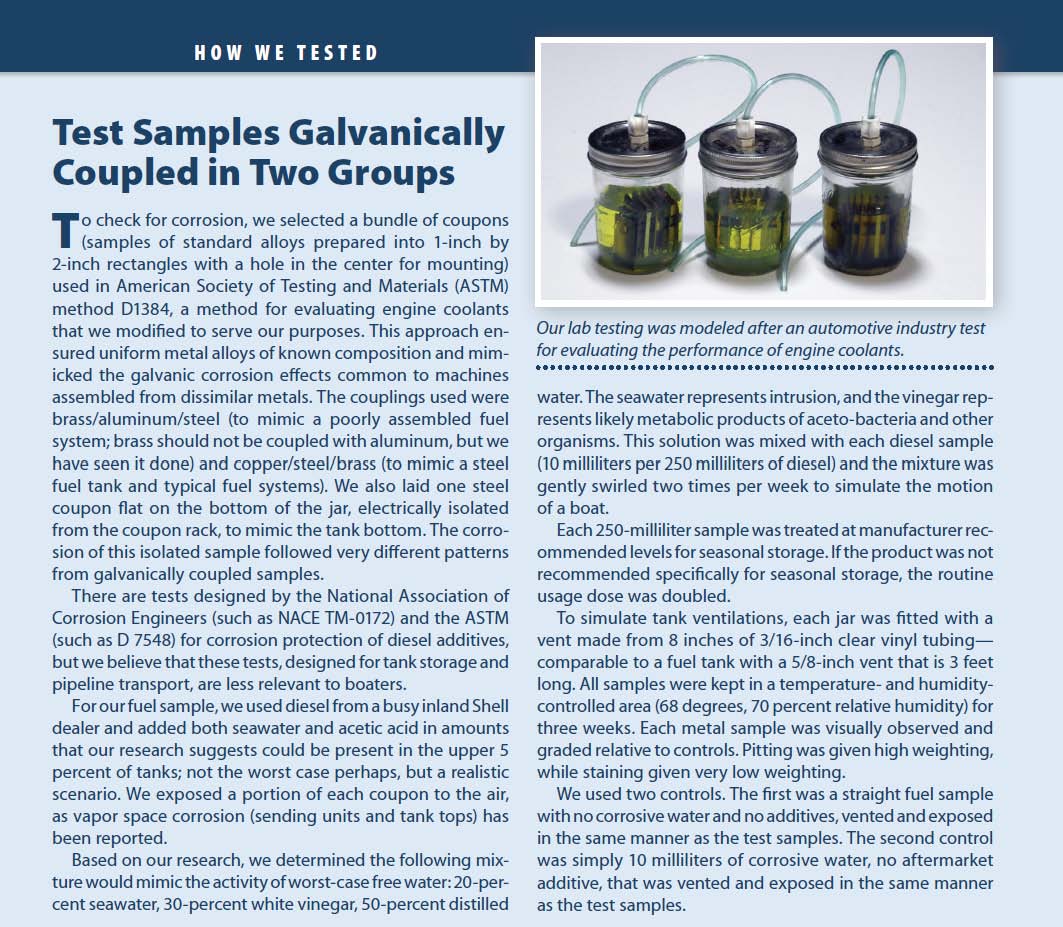

































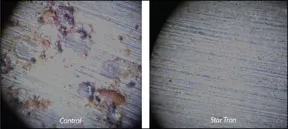





When boat is not used often does the diesel fuel need re-treatment if no new fuel is added?
I try to run my Perkins 4-108 once or twice a month, in gear at the dock @ 1200 RPM as my marine engine installer recommended.
A 40 Gallon tank (I have 2 – had to replace leaking steel tanks with Aluminum T-5000- series) lasts a very long time.
I am using Star Tron additive, but uncertain whether additional treatment is needed periodically.
Thank you.